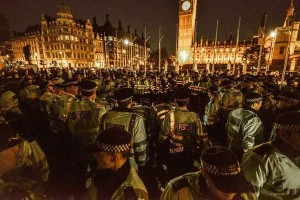 “How can a pizza box be deemed a piece of sleeping equipment? This is the increasingly surreal manner in which the Metropolitan Police has interpreted the new laws introduced since the rise of the Occupy movement in 2011” writes John Sinah who has been taking part in the on-going occupation of Parliament Square following attempts by police to break it up on Sunday.
“How can a pizza box be deemed a piece of sleeping equipment? This is the increasingly surreal manner in which the Metropolitan Police has interpreted the new laws introduced since the rise of the Occupy movement in 2011” writes John Sinah who has been taking part in the on-going occupation of Parliament Square following attempts by police to break it up on Sunday.
Called under the banner of “Occupy Democracy”, campaigners are protesting at “a huge democratic deficit” and “government that answers to profit before people” and have organised an ambitious nine day programme of assemblies, talks and events where people can come together to debate alternatives. (check out the programme here: http://occupydemocracy.org.uk)
The response of police has been kettles, “cordons”, harassment and intimidation and on a cold, rainy, Sunday night an attempt to forcibly remove protesters and the tarpaulin they were sitting on - deemed a piece of “sleeping equipment.” (umbrellas had already been confiscated).
These attempts to turn parliament square into a sterile, protest free zone have a history.
Following Brian Haw’s establishment of a peace camp in 2001, and against the backdrop of some of the biggest demonstrations in Britain’s history against the Iraq war, MPs debated the best means of removing the presence of protesters variously described as an “incredible annoyance and inconvenience”, “health and safety risk” and making the lives of parliamentary staff “intolerable” by “baying away….merely repeating themselves ad nauseam.”
The resulting provisions under the Serious Organised Crime and Police Act 2005 outlawed “unauthorised” demonstrations or static assemblies, and therefore any spontaneous protest, within the designated area and carried a punishment of up to 51 weeks imprisonment or 2,500 fine.
Although this failed to secure the eviction of Brian Haw, it did make it an offence to protest without permission from the Metropolitan Police - with Maya Evans the first protester to be convicted for reading out the names of soldiers killed during the Iraq War outside the Cenotaph. The area covered extended to Scotland Yard, the Home office and even Westminster Magistrates court where supporters of student protesters facing charges were once without irony threatened by police with arrest if they didn’t assemble into a tight fitting pen.
Despite protests and challenges to SOCPA, the Police Reform and Social Responsibility Act (PRSRA) which replaced it in 2011 whilst removing the need to ask the Chief of police for permission to protest, and covering a smaller area, created greater powers to “prevent deemed encampments and other disruptive activity” specifying “no sleeping bag, tent or structure. Any structure designed or adapted for staying.”
Whilst seeking to allay criticisms by targeting activities associated with protest rather than protest per se, it has in fact generated an assault course of hoops which protesters have to go through in order for their protest to be considered legitimate: handing significant discretionary powers to the police to define the form in which any protest may take place.
Again the backdrop to this were a series of major protests in Britain, including the 72 day occupation in 2009 in solidarity with Tamils being massacred in Sri Lanka. PRSRA came into force around the same time the Occupy movement was taking off in the US following Occupy Wall Streets occupation of Zuccotti Park.
Whilst police in recent days have appeared unsure as to whether they were enforcing PRSRA, simply following GLA orders to “keep people off the grass”, or indeed the wishes of heritage wardens patrolling the square; the heavy handed, over the top response described by one protester as “crazy” has a serious intent: designed to maintain strict control over what forms of protest are allowed to take place and to generate the impression that any protest that falls outside of these bounds can effectively be treated as criminality.
The determination of campaigners who have remained and continue to occupy despite the intimidation, is an important assertion of the right to protest
The determination of campaigners who have remained and continue to occupy despite the intimidation, is an important assertion of the right to protest; and their treatment, yet one more illustration of the brittleness of the institutions they are targeting.
Below are some suggestions of how you can support occupy democracy and get involved!


